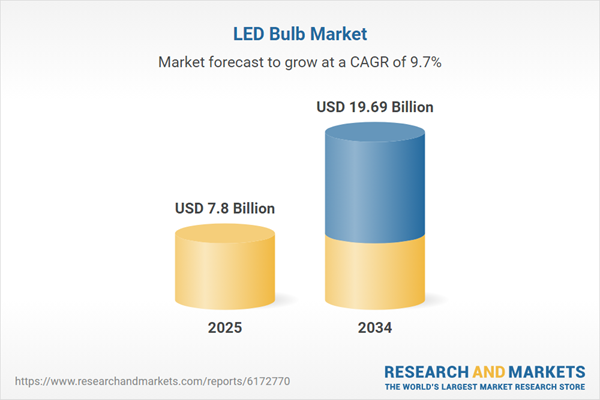Based on the application, the retrofit segment dominated the market in 2020, followed by retail and hospitality, as LED bulbs are swiftly replacing the conventional lighting systems. Regionally, India accounted for a significant share of the LED bulb market on account of the increase in the local manufacturing of LED products and several government initiatives.
Market Segmentation
Light emitting diodes (LEDs) are one of the latest technological advancements in the lighting industry. LED bulb refers to an electric lamp comprising of numerous clusters of LEDs which are mounted on a base. In comparison to the conventional lighting sources, LED bulbs are associated with many advantages such as compact size, reduced energy consumption, long lifespan, and radiate lesser heat output. Also, LED bulbs are eco-friendly and offer a better colour rendering index (CRI) with zero toxic elements. Additionally, they are available in different shapes, colours, wattages, while some models are also equipped with dimmable controls. On account of this, LED bulbs are widely used in general lighting, healthcare, signal and signage, forensics, and street lighting.Market Breakup by Application
- Retrofit
- Retail & Hospitality
- Outdoor
- Offices
- Architectural
- Residential
- Industrial
- Others
Market Breakup by Region
- North America
- Europe
- Asia-Pacific
- Latin America
- Middle East and Africa
Market Analysis
LED bulbs are widely used in various verticals such as automotive, healthcare, general lighting, mobile devices, forensic, signal and signage, street lighting, and academics. Owing to the rapid urbanisation and industrialisation in the emerging economies, the demand for LED bulbs is expected to increase across various end-use industries. Furthermore, escalating global population and increasing sales of consumer electronics is likely to create a surge in electricity consumption. Increasing consumption of electricity, however, has not been supplemented by adequate electricity production, which in turn led to the growing demand for energy-efficient products like LED bulbs.Further, increasing installations primarily drive the LED bulb market. It includes lights used in streetlights, downlights, high bays, track lights, and suspended pendants for various applications. Also, manufacturers are using unique marketing initiatives through different advertising mediums such as newspapers and television to increase consumer awareness about the advantages of these bulbs and expand their consumer base. Additionally, various awareness campaigns and policies in various countries for environmental protection and energy conservation are expected to augment the demand for LED bulbs over the forecast period. Also, constant encouragement by government and other regulatory bodies, along with rising product awareness amongst the population, is expected to impel the market growth. As a result, LED bulbs have emerged as one of the significant energy-efficient lighting solutions, which are envisaged to drive the LED bulb market forward in the coming years.
Competitive Landscape
The report gives a detailed analysis of the following key players in the global LED bulb market, covering their competitive landscape, capacity, and latest developments like mergers, acquisitions, and investments, expansions of capacity, and plant turnarounds:- General Electric Company
- Cree Lighting
- Osram
- Signify Holding
- Others
Table of Contents
Companies Mentioned
The key companies featured in this LED Bulb market report include:- General Electric Company
- Cree Lighting
- Osram
- Signify Holding
Table Information
| Report Attribute | Details |
|---|---|
| No. of Pages | 166 |
| Published | August 2025 |
| Forecast Period | 2025 - 2034 |
| Estimated Market Value ( USD | $ 7.8 Billion |
| Forecasted Market Value ( USD | $ 19.69 Billion |
| Compound Annual Growth Rate | 9.7% |
| Regions Covered | Global |
| No. of Companies Mentioned | 5 |









